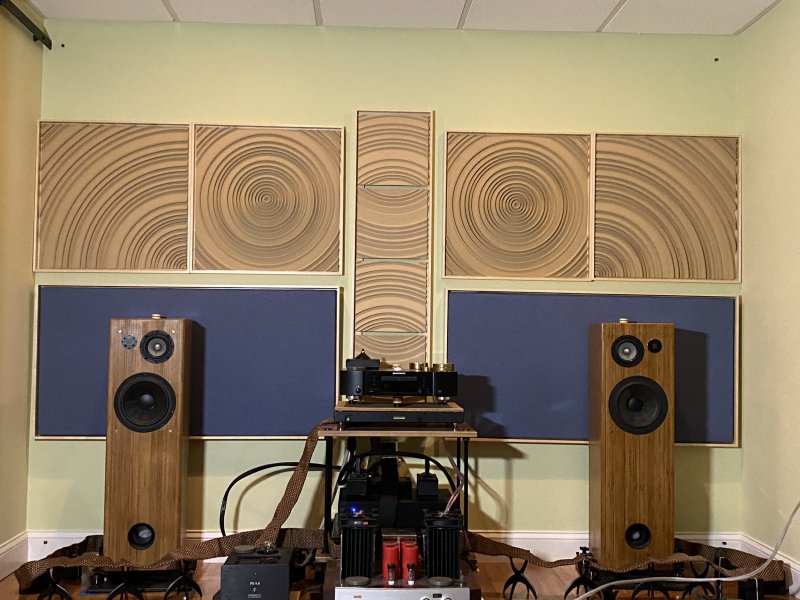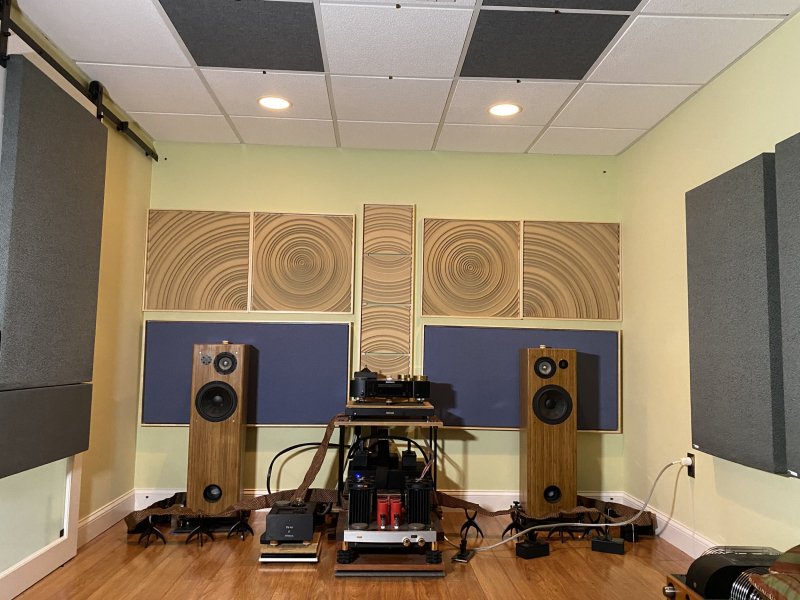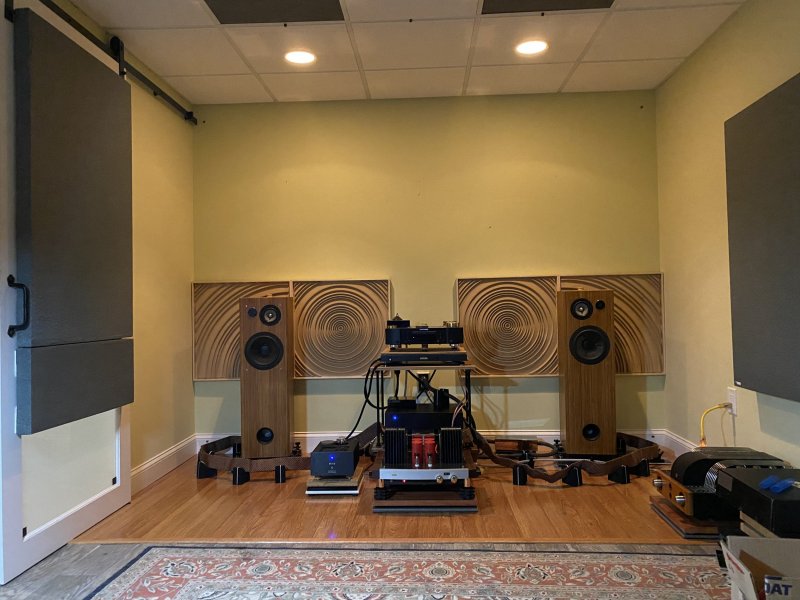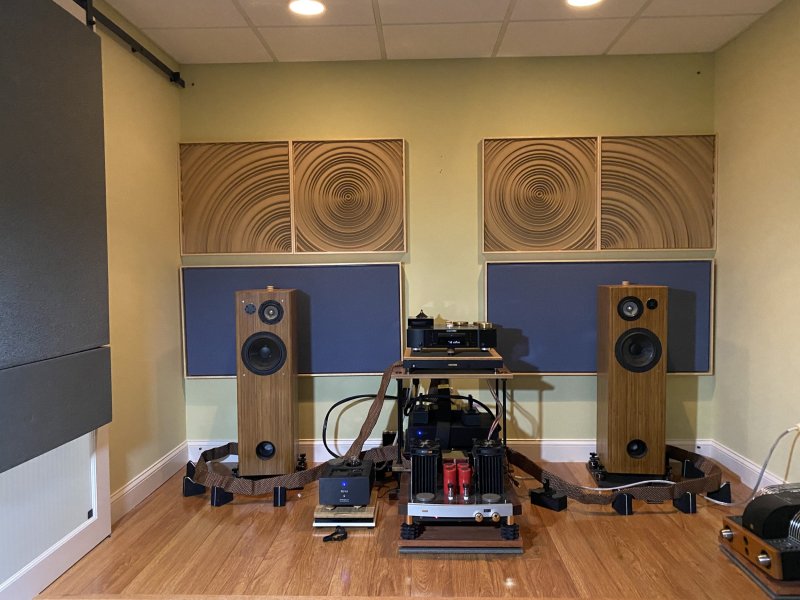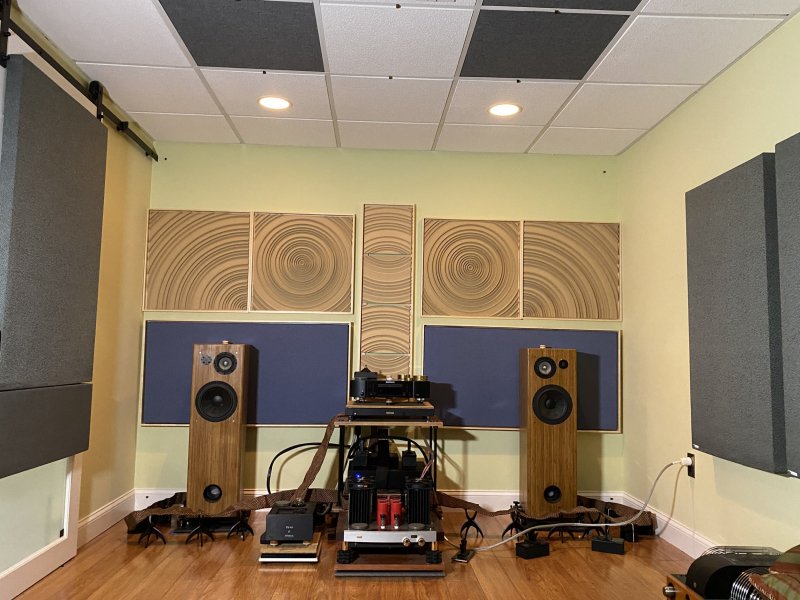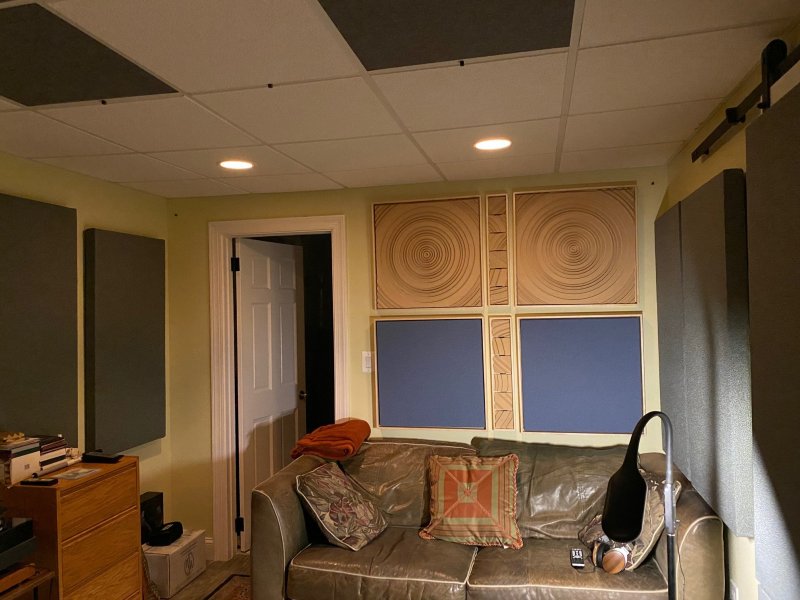Trying the ZR Acoustics Panels
- Thread starter Cellcbern
- Start date
You are using an out of date browser. It may not display this or other websites correctly.
You should upgrade or use an alternative browser.
You should upgrade or use an alternative browser.
Looking at your photos, you appear to be using the panels individually rather than covering a wall or significant part of a wall surface with them, which means that you don't have the minimum recommended coverage on any wall surface. It follows that you are not going to get the same level of benefit that I am getting. Again, coverage is simple in my room whereas you have windows and other challenges that I don't face. And unfortunately achieving minimum recommended coverage for you would require purchasing additional panels. If you are going to stop at eight ZR panels you might consider grouping four ZR panels in each corner behind the monitors, and getting conventional absorbers on stands for in front of each window/behind the sub.So some surprising observations after a few experiments. In an attempt to confirm real, audible differences, I took the 8 panels in and out of the room several times, playing a few tracks over and over to make sure an improvement could be heard.
My previous experience was correct and it reproduced the same results. Improved soundstage, better instrument tone, realism and spacing. Not, "blow you out of the water", but still good improvements. The panels had less of an effect on vocals but some improvement nevertheless.
But here's where things got interesting. First, in my previous house/room I had the 851N streamer and compared it's digital pre-amp vs the Wyred4sound STP-SE 2. The STP-SE 2 was way better, less digital, cleaner and higher resolution. Same thing with the Ares DAC vs the 851N DAC - better bass and less of a digital sound. Without the panels, in the new house/room the differences were there but less so than my previous room. I would attribute this to the room acoustics and that I just simply had a better room before (which is true especially in the bass response).
However - with the panels in the room, I had a really hard time hearing ANY difference between the preamp/DAC switch. And this was done in a way where I was able to toggle between input 1 (STP-SE/Ares) and input 2 (set as bypass for the 851N) immediately during playback. I did the test comparing both the pre-amp portion and DAC portion separately and later together. No difference. I am going to try this experiment with my other two amplifiers I use for the home theater and even my 25 year old pioneer Elite receiver. Will also see if it sounds different with my midfi turntable setup.
As mentioned earlier, in their temporary placement, the panels has not solved my bass issues and the same frequency issues will most likely show up in the room measurements once I find the (quiet) time to accurately take those measurements. Granted, I only have 8 panels, covering only 16 total sqft of front wall space so I never expected it to solve all my issues, including bass. I believed from the very beginning it will take a combination of further bass trap treatment, an active crossover for the sub and monitors and continuing to adjust placement of panels and speakers. Last option could be to replace the speakers all together with something of a sealed design or at least without a rear port.can you post some REW measurements with and without the panels? This will be very interesting as the claim was that these panels will fix the bass problems.
They do make an improvement to my room but I have not compared them directly to traditional room treatment options and may order some bass absorption and diffusion panels from somewhere like GIK. If they don't work well, I could always use some additional treatment where the HT system is since that room is in need of some reduced reflections. I'll work on trying to get some measurements taken when everyone is out of the house for a few hours.
The problem is the windows are directly behind the speakers. I have played with their placement and due to the dimensions of the room, adjusting the width of the speakers in either direction do not sound (or measure) as good. There is more flexibility in moving them forward or backward, but they sound best where they currently sit.Looking at your photos, you appear to be using the panels individually rather than covering a wall or significant part of a wall surface with them, which means that you don't have the minimum recommended coverage on any wall surface. It follows that you are not going to get the same level of benefit that I am getting. Again, coverage is simple in my room whereas you have windows and other challenges that I don't face. And unfortunately achieving minimum recommended coverage for you would require purchasing additional panels. If you are going to stop at eight ZR panels you might consider grouping four ZR panels in each corner behind the monitors, and getting conventional absorbers on stands for in front of each window/behind the sub.
There are still some reflection issues but as I have added drapes and padding under the floor rug, it has made small improvements. Will try to keep playing with the panel placements and see how they sound directly (4 panels together) behind each speaker or all grouped in the center.
Experimenting with a 25 year old Pioneer Elite receiver produced some surprising results. Used RCA interconnects and about 10 feet of lamp cord for wires vs Transparent cables and Mogami Gold Balanced cables. All music streamed through the 851N. It was not nearly the difference I thought it would be based on the components. Smaller, flatter soundstage, less detail but the vocals were not that far off. Most of the music was THERE and still sounded good. Again, took the panels out of the room and those differences were more pronounced. I've heard far more differences with different speakers in the room compared with electronics (without any panels previously).
It seems the electronics matter much less here compared to my previous space. I always believed the speaker interaction with the room was the largest factor of reproduction and in this case it is determining 80% to 90% of the sound.
It seems the electronics matter much less here compared to my previous space. I always believed the speaker interaction with the room was the largest factor of reproduction and in this case it is determining 80% to 90% of the sound.
Finally finished deployment of the ZR Acoustics panels behind the listening position. Still have to figure out what to do with the narrow section of wall/corner on the other side of the doorway to the bathroom, as well as that doorway itself. Currently have absorber panels in the bath-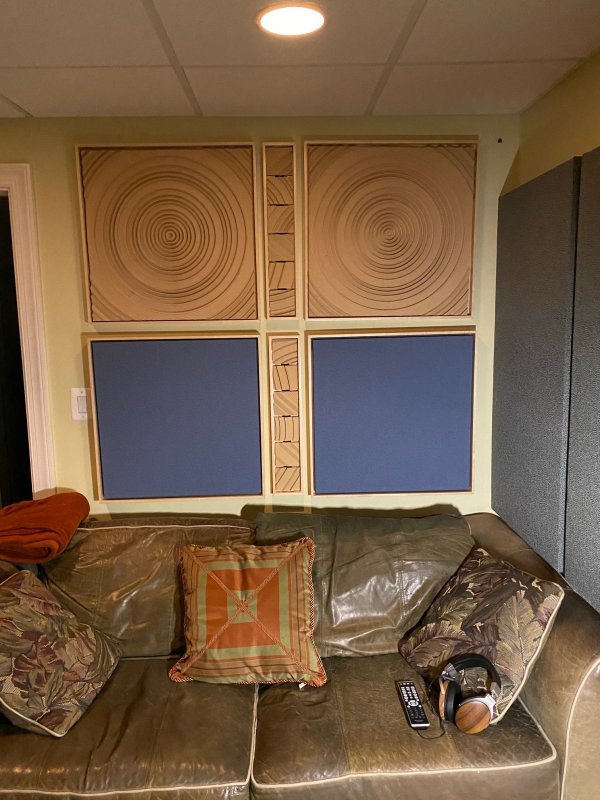
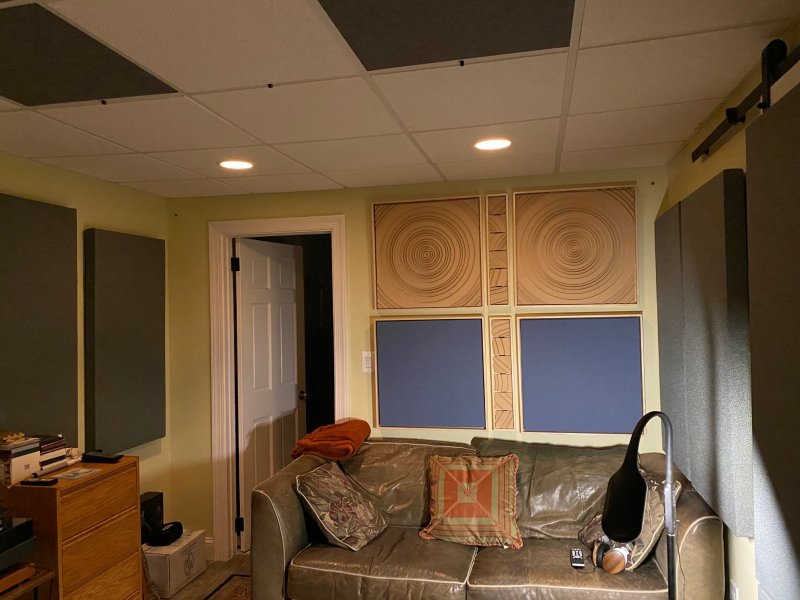 room and leave the door open for listening, but could also close the door and put panels on it. Strictly speaking I should replace that (reflective) leather sofa with fabric seating, but my wife is fond of it and it doesn't seem to be hurting sound quality a lot.
room and leave the door open for listening, but could also close the door and put panels on it. Strictly speaking I should replace that (reflective) leather sofa with fabric seating, but my wife is fond of it and it doesn't seem to be hurting sound quality a lot.

 room and leave the door open for listening, but could also close the door and put panels on it. Strictly speaking I should replace that (reflective) leather sofa with fabric seating, but my wife is fond of it and it doesn't seem to be hurting sound quality a lot.
room and leave the door open for listening, but could also close the door and put panels on it. Strictly speaking I should replace that (reflective) leather sofa with fabric seating, but my wife is fond of it and it doesn't seem to be hurting sound quality a lot.
Last edited:
In addition to their significant performance advantage over conventional acoustic panels I love the aesthetics of the bare wood ZR "Sample Rate" panels, which look like wall art and provide a lot of flexibility from an aesthetic standpoint given the different patterns and sizes. Some wooden diffusers are also attractive but they are typically thick, heavy, only available in large sizes, and don't address as much of the frequency spectrum as ZR panels do. You can't use appearance/WAF as an excuse for not dealing with room acoustics anymore.
I have read this entire thread and am totally confused and cannot think of a way to test for myself!!!!
What are you finding confusing? What questions can I answer for you?I have read this entire thread and am totally confused and cannot think of a way to test for myself!!!!
The way I tested them was to buy four 2' x 2' panels and try them behind my speakers in place of my combination of GIK absorbers and RPG BAD combination (absorption and diffusion) panels. Because 16 sf of ZR panels sounded so much better than 24 sf of GIK and RPG I bought enough additional ZR panels to have the manufacturer's minimum recommended coverage in sf. I kept the BAD and GIK panels on the side walls and ceiling because of the cost of the ZR panels, and because DHDI says their research shows that the wall behind the speakers is the most important wall for deploying their panels. My ears tell me that the wall behind the listening position is the 2nd most important wall for deploying ZR Panels, and that with these two walls addressed the room sounds fabulous with conventional panels on the side walls and ceiling. So if I have a windfall I may replace the side wall panels with ZR but I feel no urgency to do so.
Short of buying several I'm not sure how you could test them in your listening room. I'm not aware of DHDI providing loaners, but you could ask. They have a shitload of pro audio installations (google DHDI Portfolio). Maybe one of their customers will let you come listen to their room.
Short of buying several I'm not sure how you could test them in your listening room. I'm not aware of DHDI providing loaners, but you could ask. They have a shitload of pro audio installations (google DHDI Portfolio). Maybe one of their customers will let you come listen to their room.
My confusion stems from where to put them and which and how many to buy? Thank you for your assistance.What are you finding confusing? What questions can I answer for you?
DHDI says that their research/testing revealed that the wall directly behind the speakers is the most important to treat, and that the speakers should be right up against the panels/wall - as close as possible. I followed this recommendation (as did the Stereophile reviewer) with good results. I started off with four of the bare wood ("Sample Rate") panels in the position where the blue "Hybrid" panels are in my latest photos. DHDI says that you need to cover a minimum of half the square footage (sf) of the wall for best results, which I have now done, but I got a dramatic improvement with just 16 sf of panels on a 70 sf wall. Based on all of the photos I've seen I think you have to have a panel directly behind each speaker's radiating area (the area of the front panel where there are drivers) that is at least twice the sf of that area. Note that when I tried pulling the speakers out away from the wall/panels I lost some of the effect of the panels (reduction in clarity), which suggests that if you don't put your speakers right up against the panels you will need more sf of panel coverage. Note also that I bought both the Hybrid and Sample Rate panels to test, however I do not hear a big difference between the two. The Hybrid panel is already in a wooden box type frame and is therefore more durable and easier to handle than a Sample Rate panel. The ZR panels are designed to be installed with Velcro on a cloth studio wall, but I was not able to make this work in my home. The Sample Rate panels in particular are very delicate and can be broken just through routine handling. I put each ZR panel (Hybrid and Sample Rate) in a floater frame (the type used for canvas art) to protect them, and hung each one with a wire and hook like framed artwork. Note also that I deliberately put the ZR panels up against the side walls (into the corners) even though that left a gap in the middle so they could reduce the pressure buildup in the corners. Since the wall area behind the listening seat is smaller than the area behind the speakers (there is a door to a bathroom on the rear wall) I was able to cover the whole thing with 16 sf of panels and a small strip of SR 4 (4" square) panels in the middle. To sum up, I think you should start with the minimum amount of sf on the wall behind the speakers and add incrementally until you stop hearing an improvement. DHDI recommends a mix of Hybrid and Sample Rate panels which I have, but the technology is in the Sample Rate panels - the Hybrid panels are Sample Rate panels in a box frame with a thin later of absorbing material, covered in acoustical fabric. The Sample Rate panels are cheaper and you could get away with just using them, but when you consider the necessity of putting them in some kind of box or frame it is a wash. If you are starting out with ZR Acoustics panels I would focus on the front and rear walls and use inexpensive GIK absorbers at the side wall first reflection points. Without knowing your room dimensions or what speakers you are using I cannot be more specific. See my progression in photos below:My confusion stems from where to put them and which and how many to buy? Thank you for your assistance.
Last edited:
My take on these panels is that they should have some positive effect on the bass when placed on the front wall behind the speakers as they recommend. They will repeatedly "scrub" the bass waves that bounce side to side and up and down in the front of the room, helping to reduce what we here at ASC call "head end ringing." Any rough surface will attenuate a sound wave moving parallel to that surface, and these provide a very rough surface. If a bass wave hits them perpendicularly they will have almost no effect, so front to back bass reflections are not addressed unless these panels are placed all along the ceiling and side walls. I'd like to see some measurements before and after. REW's C50 clarity before and after would be worth looking at to see how low they go and how much they increase measured clarity.
I suspect they do have "some positive effect", and on more than the bass. Just look at the list of film/recording studio and mastering lab clients:My take on these panels is that they should have some positive effect on the bass when placed on the front wall behind the speakers as they recommend. They will repeatedly "scrub" the bass waves that bounce side to side and up and down in the front of the room, helping to reduce what we here at ASC call "head end ringing." Any rough surface will attenuate a sound wave moving parallel to that surface, and these provide a very rough surface. If a bass wave hits them perpendicularly they will have almost no effect, so front to back bass reflections are not addressed unless these panels are placed all along the ceiling and side walls. I'd like to see some measurements before and after. REW's C50 clarity before and after would be worth looking at to see how low they go and how much they increase measured clarity.

I suspect they do have "some positive effect", and on more than the bass. Just look at the list of film/recording studio and mastering lab clients:

For the sake of comparison I googled Acoustic Sciences Corporation "Portfolio" and "Commercial Client List". Here is a link to what my search turned up:I suspect they do have "some positive effect", and on more than the bass. Just look at the list of film/recording studio and mastering lab clients:

https://www.acousticsciences.com/pro/projects-studio/
The trade secret, what makes ZR Acoustics panels work as claimed is a precise, specific size, angle, and pattern of non-parallel surfaces. Hanson Hsu was granted U.S. Patent #9,845,598 for the original Zero Reflection panel design. The current circular one that they use (as in my photos) is an advancement on and superceded that original design. In fact, DHDI claims that as long as the trade secret angles/patterns are maintained the ZR technology can be incorporated in something as thin as a window curtain:My take on these panels is that they should have some positive effect on the bass when placed on the front wall behind the speakers as they recommend. They will repeatedly "scrub" the bass waves that bounce side to side and up and down in the front of the room, helping to reduce what we here at ASC call "head end ringing." Any rough surface will attenuate a sound wave moving parallel to that surface, and these provide a very rough surface. If a bass wave hits them perpendicularly they will have almost no effect, so front to back bass reflections are not addressed unless these panels are placed all along the ceiling and side walls. I'd like to see some measurements before and after. REW's C50 clarity before and after would be worth looking at to see how low they go and how much they increase measured clarity.

ZR QuanTex
Thin as velvet and elegant as victorian drapes, custom ZR Fabrics are lush, beautiful and imbued with the ability to make sound vanish. The latest evolution in Quantum Acoustics is concealed within any beautiful drape, curtain or textile that your architect or interior designer can envision...
 deltahdesign.com
deltahdesign.com
Last edited:
In the higher frequencies I don't think there's too much doubt about how the surfaces on those panels could be beneficial. In the bass, it's not always clear to everyone how that works. That's why I specifically mentioned the bass. At first glance it seems the surface is inadequate to affect bass waves - quantum shaping or otherwise. But when you consider waves passing parallel to the surface in an enclosed space you can get effects going into lower frequencies than some might expect.I suspect they do have "some positive effect", and on more than the bass. Just look at the list of film/recording studio and mastering lab clients:

Can you elaborate on what you mean by waves passing parallel to the surface?In the higher frequencies I don't think there's too much doubt about how the surfaces on those panels could be beneficial. In the bass, it's not always clear to everyone how that works. That's why I specifically mentioned the bass. At first glance it seems the surface is inadequate to affect bass waves - quantum shaping or otherwise. But when you consider waves passing parallel to the surface in an enclosed space you can get effects going into lower frequencies than some might expect.
Similar threads
- Replies
- 7
- Views
- 2K
- Replies
- 10
- Views
- 2K
- Replies
- 47
- Views
- 4K
- Replies
- 4
- Views
- 1K
| Steve Williams Site Founder | Site Owner | Administrator | Ron Resnick Site Owner | Administrator | Julian (The Fixer) Website Build | Marketing Managersing |


